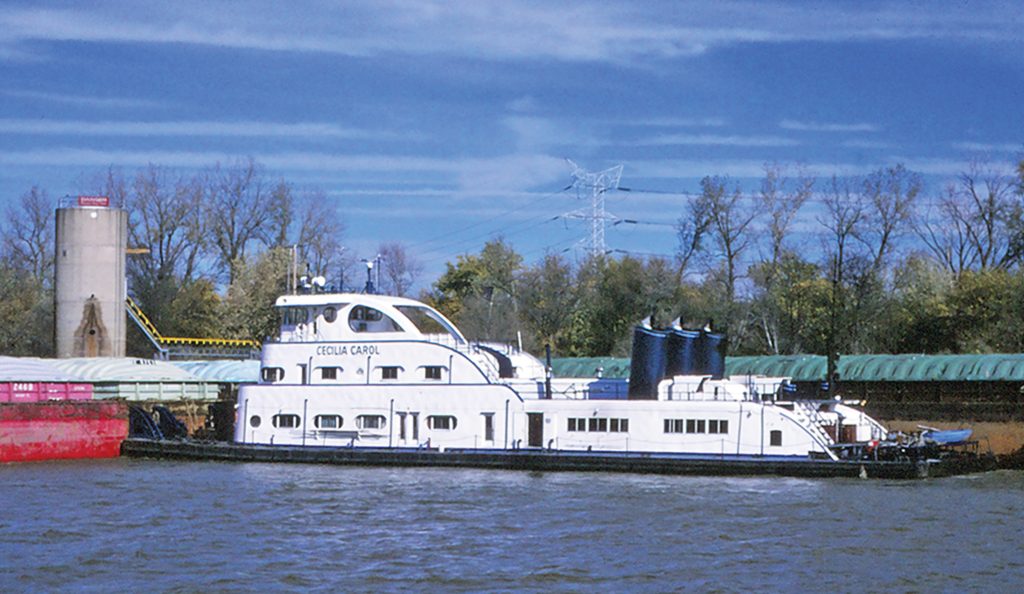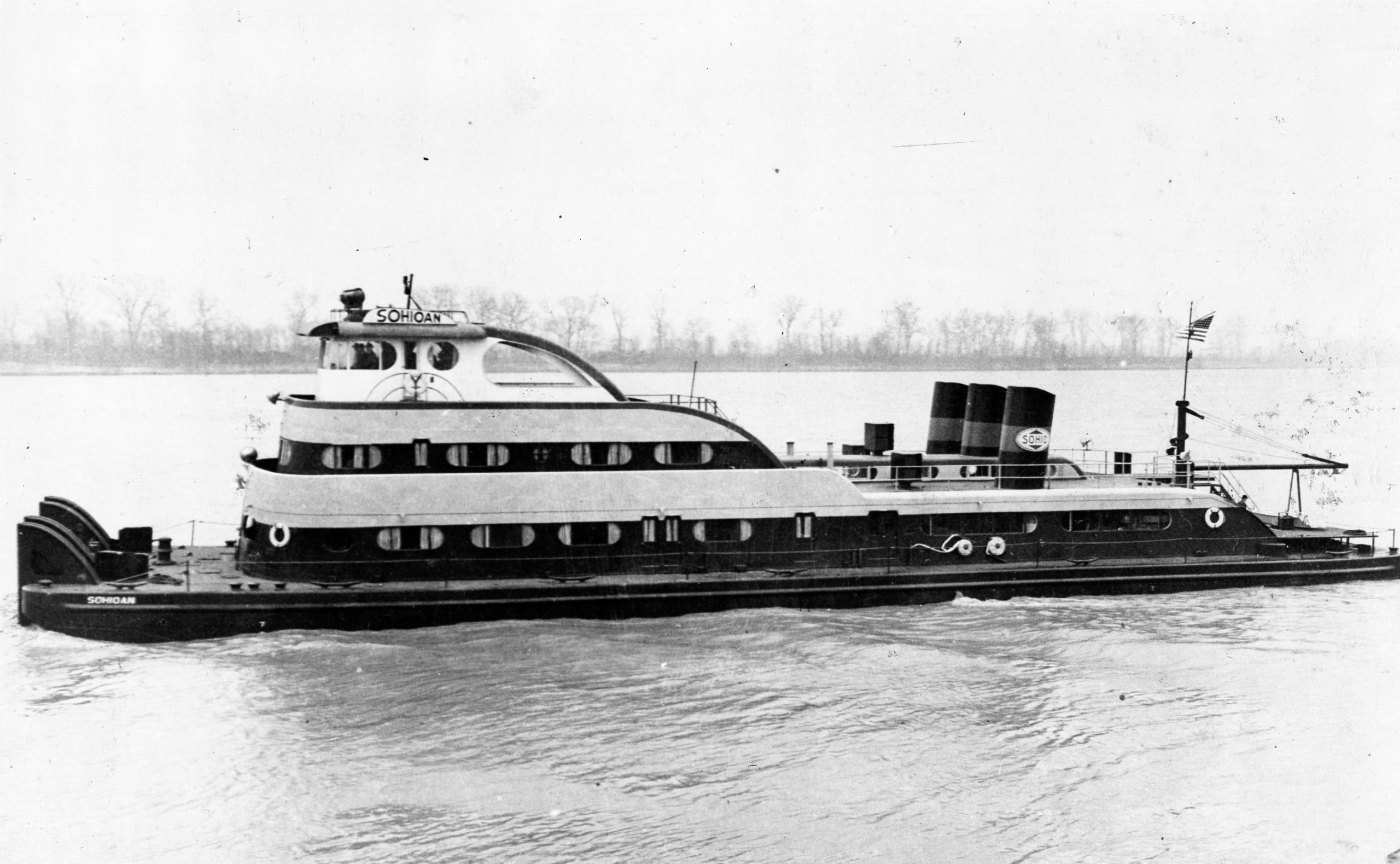Standard Oil was founded in 1870, and by the turn of the 20th century had become a giant entity, so much so that it drew the attention of the antitrust interests, who considered it a monopoly. In 1911, the U.S. Supreme Court found Standard Oil to be in violation of the Sherman Antitrust Act and ordered it split into 34 different companies. One of these was the Standard Oil Company of Ohio (commonly known as Sohio). In 1923, this company took delivery of a gas-powered sternwheel towboat and a tank barge from the Marietta Manufacturing Company of Point Pleasant, W.Va.
That sternwheeler was the Standard (featured in the December 25, 2023, issue of The Waterways Journal), which was sold in 1939, when it was replaced by the Sohio (See WJ, January 7, 2024), a 400 hp. boat powered by a single Atlas Imperial diesel engine. In 1943, likely due to the critical need to move crude oil and finished petroleum products during World War II, Sohio made a big addition to the company’s modest fleet.
The new vessel was built by St. Louis Shipbuilding & Steel Company, a firm detailed often in this column. Founded in 1933 by Herman T. Pott and two partners, the company grew from building relatively small, obscure towboats to constructing some of the largest diesel craft on the rivers in just one decade of existence. This new towboat for Sohio set a new precedent.
The new vessel was christened the Sohioan and was of all-steel construction. The hull measured 160 by 38 feet with triple props. The cabins and pilothouse were of a very streamlined design, reminiscent of the automobiles of the era. Three slightly canted smokestacks rose from an area on the after section of the main cabin roof due to the engines being located farther aft than typical in order to reduce shafting and vibration. There was no traditional overhang at the top of each cabin. The boat was powered by three Fairbanks-Morse seven-cylinder, direct-reversing diesel engines and was touted as the most powerful towboat on the rivers in 1943 at 2,415 hp.
The vessel created quite a stir, and an Associated Press wire photo of “the new streamlined Sohioan” on trials at St. Louis appeared in newspapers nationwide. Fairbanks-Morse had ads featuring it as well, which were headlined with “Oil for the Lamps of Liberty.” The text stated, “Oil keeps the home fires burning … and the Standard Oil Company’s newest river tugboat ‘Sohioan’ gets it there.” It went on to say, “We at Fairbanks-Morse congratulate the St. Louis Shipbuilding & Steel Company and the Standard Oil Company for helping to grease the skids of the Axis.”
The Sohioan went right to work towing both crude oil from the south to refineries along the river system as well as delivering gasoline, diesel fuel and other refined products to various terminals. In June 1944, Sohio purchased the 1,300 hp. Edgar C. Johnston, renamed it Sohio Memphis and used it to further the war effort. Following the war in 1946, kort nozzles were installed on the Sohioan at St. Louis Ship. By 1947, Sohio
had acquired three of the 2,000 hp. DPC steam prop towboats and sold the small Sohio.
In 1950, Sohio reduced the size of its river fleet, and the Sohioan was sold to The Ohio River Company (ORC) of Cincinnati. The name was changed to Charles R. Stevenson, and for the next 19 years it was a fixture on the upper Ohio River. At the time, ORC had three steam sternwheel towboats, each rated at 1,000 hp., and some diesel boats that were as much as 1,600 hp. Nothing, though, compared to the 2,415 hp. of the Stevenson. Among the employees of ORC, the big boat had the nickname of “Scrap Iron Charlie,” as it was said to steer so strongly that it could turn rigging into scrap iron. At some point, the kort nozzles were removed.
The Stevenson was noted for the sound and vibration of the three Fairbanks engines. In homes along the river, windows would rattle, and this author has personally felt the vibrations through the ground when it was near. The engines were controlled by three mechanical control heads in the pilothouse, each having two levers, one to start the engine and the other to set engine speed. One pilot that stood watches aboard it told this author, “You had to be built like an octopus to run that thing!”

In 1969, the Charles R. Stevenson was sold to Capt. Bob Bosworth’s fledgling G&C Towing Inc., Point Pleasant, W.Va. There, it was most often on charter to Ashland Oil, towing petroleum products from Catlettsburg, Ky., to Pittsburgh. It was not uncommon to see it depart northbound with 15 loads on any river stage, even at only 2,415 hp. In 1973, the boat was sold to Resort Hotels Inc. It was repowered in 1974 with GM 12-645CE2 diesels and Falk 3.05:1 reduction gears, which produced 4,200 hp.
Under this ownership, it was operated by Consolidated Towing Company, Excelsior Springs, Mo., and renamed Cecilia Carol. In 1977, it was first leased to Port City Towing Company of Greenville, Miss. Port City Towing then acquired it in 1981. It was leased to White River Fleeting Inc. in 1983, then to Triangle Marine in 1984, both of Greenville. In 1986, it was sold to Mississippi-Alabama Boat Leasing Inc., Vicksburg, Miss., and was sold for a final time in 1988 to American Boat & Towing Company, Cahokia, Ill.
The Inland River Record reported the boat as having been scrapped in 2005.
Featured image caption: The Sohioan new at St. Louis Ship in 1943. (Photo from the Dan Owen Boat Photo Museum collection)




